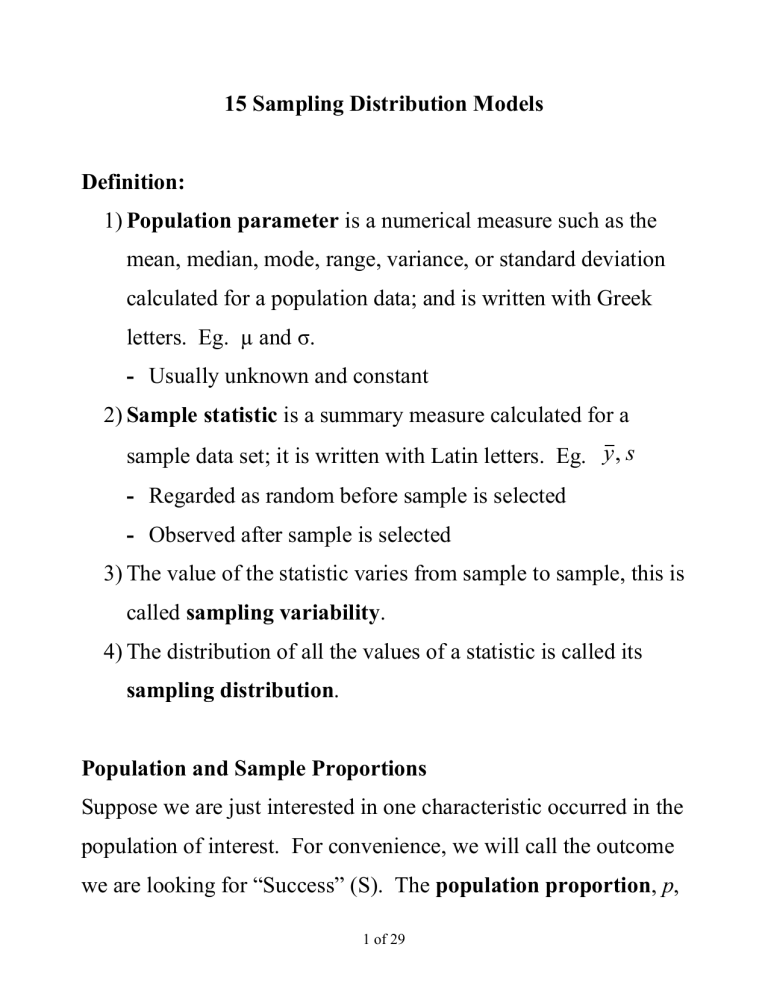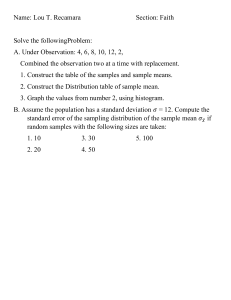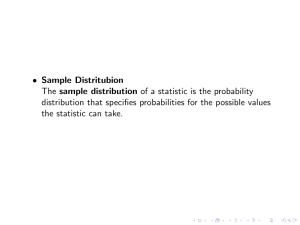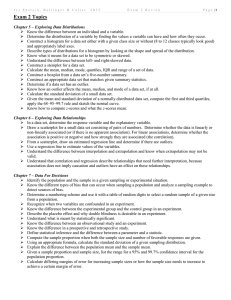
15 Sampling Distribution Models Definition: 1) Population parameter is a numerical measure such as the mean, median, mode, range, variance, or standard deviation calculated for a population data; and is written with Greek letters. Eg. µ and σ. - Usually unknown and constant 2) Sample statistic is a summary measure calculated for a sample data set; it is written with Latin letters. Eg. y, s - Regarded as random before sample is selected - Observed after sample is selected 3) The value of the statistic varies from sample to sample, this is called sampling variability. 4) The distribution of all the values of a statistic is called its sampling distribution. Population and Sample Proportions Suppose we are just interested in one characteristic occurred in the population of interest. For convenience, we will call the outcome we are looking for “Success” (S). The population proportion, p, 1 of 29 is obtained by taking the ratio of the number of successes in a population to the total number of elements in the population. Example for population proportion: - check for N students, how many are "nonresidents". - check how many out of N patients survived at least five years, after a specific cancer treatment. Recall: N is population size. Looking at a SRS of the size n from a large population, the probability p can be estimated by calculating the sample proportion (relative frequency) of Successes, p̂ . That is, pˆ number of Successes( S) in thesample . sample size Example for sample proportion: - flip n coins and observe if “Tail” was tossed. - look at n random persons and survey how many have an IQ above 120. - look at n random students and survey how many have more than two siblings. 2 of 29 Example: Suppose a total of 10,000 patients in a hospital and 7,000 of them like to play basketball. A sample of 200 patients is selected from this hospital, and 128 of them like to play basketball. Find the proportion of patients who like to play basketball in the population and in the sample. Find the sampling error for this case while assuming that the sample is random and no nonsampling error has been made. Sampling error = 15.1 The Sampling Distribution of a Sample Proportion ( p̂ ) - Consider two different samples from a population, which you want to use for estimating the proportion of people with more than 2 siblings in the population. Use the statistic "proportion" for both samples. Are the outcomes the same? - Most likely not! This is known as sampling variability. - imagine we draw many samples and look at the sample proportions for these samples. 3 of 29 - The histogram we’d get if we could see all the proportions from all possible samples is called the sampling distribution of the proportions. - What would the histogram of all the sample proportions look like? - We would expect the histogram of the sample proportions to center at the true proportion, p, in the population. - RULE 1: p̂ is the mean of the sampling distribution of p̂ equals p: pˆ p Notation: p̂ is also denoted as p̂ - RULE 2: The standard deviation of the sampling distribution of p̂ , p̂ , is: pˆ p(1 p) n Notation: p̂ is also denoted as SD pˆ . NOTE: the standard deviation of a sampling distribution is called a standard error. Thus, SD pˆ is called a standard error. 4 of 29 - What about the shape of the sampling distribution of the proportions? - It turns out that the histogram is unimodal, symmetric, and centered at p. - More specifically, the sampling proportion p̂ is approximately normal distributed for large n. (Central Limit Theorem) RULE 3: A rule of thumb states that the sample size is considered to be sufficiently large if: np ≥ 10 and n(1 – p) ≥ 10 NOTE: When n is large and p is not too close to 0 or 1, the sampling distribution of p̂ is approximately normal. The further p is away from 0.5, the larger n must be for accurate normal approximation of p̂ . - A sampling distribution model for how a sample proportion varies from sample to sample allows us to quantify that variation and how likely it is that we’d observe a sample proportion in any particular interval. - So, the distribution of the sample proportions is modeled with a probability model that is N p, 5 of 29 pq n - Because we have a Normal model, for example, we know that 95% of Normally distributed values are within two standard deviations of the mean. So we should not be surprised if 95% of various polls gave results that were near the mean but varied above and below that by no more than two standard deviations. Example: Which Brand of Pizza Do You Prefer? • Two Choices: A or D. • Assume that half of the population prefers Brand A and half prefers Brand D. • Take a random sample of n = 3 tasters. Find the sampling distribution for the sample proportion. Find the mean and standard deviation. 6 of 29 Sample No. Prefer Proportion Sample Pizza A Proportion Probability (A,A,A) 3 1 0 1/8 (A,A,D) 2 2/3 1/3 3/8 (A,D,A) 2 2/3 2/3 3/8 (D,A,A) 2 2/3 1 1/8 (A,D,D) 1 1/3 (D,A,D) 1 1/3 (D,D,A) 1 1/3 (D,D,D) 0 0 7 of 29 15.2 Assumptions and Conditions - Most models are useful only when specific assumptions are true. - There are two assumptions in the case of the model for the distribution of sample proportions: 1. The Independence Assumption: The sampled values must be independent of each other. 2. The Sample Size Assumption: The sample size, n, must be large enough. - Assumptions are hard—often impossible—to check. That’s why we assume them. - Still, we need to check whether the assumptions are reasonable by checking conditions that provide information about the assumptions. - The corresponding conditions to check before using the Normal to model the distribution of sample proportions: Randomization Condition: The sample should be a simple random sample of the population. 10% Condition: If sampling has not been made with replacement, then the sample size, n, must be no larger than 10% of the population. 8 of 29 Success/Failure Condition: The sample size has to be big enough so that both np and nq are at least 10. With these sampling distributions, we can apply standardization in order to find the probability for the proportion of Successes. The z value for a value of p̂ is: z pˆ pˆ pˆ pˆ p p(1 p) , n which is well approximated by the standard normal distribution. Example: A study showed that the proportion of people in the 20 to 34 age group with an IQ (on the Wechsler Intelligence Scale) of over 120 is about 0.35. Let p̂ = proportion of the sample with an IQ of at least 120. a) Find the mean and standard deviation of sample proportion 9 of 29 b) What can you say about the distribution of sample proportion? c) Find the probability for the event that in a sample of 50 there are more than 30 people with an IQ of at least 120. Example: In an experiment, 32 subjects made a total of 60,000 guesses on a set of 5 symbol cards. Pure chance would give around 12,000 correct guesses, but the subjects had a total of 12,489 correct guesses. 10 of 29 a) Find the mean and standard deviation of the sample proportion of correct guesses. b) What can you say about the distribution of sample proportion of correct guesses? c) Could this excess of 489 good guesses just be good luck? In other words, calculate the probability for the event that in the total guesses, there are more than 12489 correct guesses. 11 of 29 Example: (Please try it on your own) Suppose that the true proportion of people who have failed a professional exam is 0.87. A sample consists of 158 people is randomly drawn. a) Find the mean and standard deviation of the sample proportion of people failed to pass the professional exam? b) What can you say about the distribution of sample proportion? c) Find the probability that the sample proportion of people failed to pass the professional exam exceeds 0.94. 12 of 29 15.3 The Sampling Distribution of Other Statistics What about Quantitative Data? - Proportions summarize categorical variables. - The Normal sampling distribution model looks like it will be very useful. - Can we do something similar with quantitative data? - We can indeed. Even more remarkable, not only can we use all of the same concepts, but almost the same model. Example: The population is a class of 5 Stat 151 students. Let be the population mean of their weight. Select a random sample of size 3 and observe the average weight y . We must be careful to distinguish this number y from . How can y , based on a sample of a small percentage of the class, be an accurate estimate of ? After all, a second sample would give a different value of y . This basic fact is called sampling variability (the value of a statistic varies in repeated random sampling). 13 of 29 Now suppose you look at every possible random sample from this Stat 151 population and the corresponding sample mean. For these numbers, you can create the sampling distribution. Population Data Student Weight All possible samples of size 3 Possible Weight in the y Samples sample A 70 ABC 70, 75, 75 73.3333 B 75 ABD 70, 75, 75 73.3333 C 75 ABE 70, 75, 80 75 D 75 ACD 70, 75, 75 73.3333 E 80 ACE 70, 75, 80 75 ADE 70, 75, 80 75 BCD 75, 75, 75 75 BCE 75, 75, 80 76.6667 BDE 75, 75, 80 76.6667 CDE 75, 75, 80 76.6667 NOTE: The total number of samples: 5C3 = 10 14 of 29 Freq and Rel. Freq Distns of y when the sample size is 3 y Freq Weight in the sample 73.3333 3 3/10 75 4 4/10 76.6667 3 3/10 Sampling Distribution of y when the sample size is 3 y P( y ) 73.3333 .3 75 .4 76.6667 .3 Total 1 NOTE: µ = 75 y 73.3333 .3 75 .4 76.6667 .3 75 Remark: 1. The value of y differs from one random sample to another (sample variability). 15 of 29 2. Some samples produced y values larger than μ, whereas other produce y smaller than μ. 3. They can be fairly close to the mean μ, or also quite far off from the population mean μ (even it rarely happens). A histogram of all these different y values would give some insight into the accuracy of this estimation procedure. Consider another Stat 151 class consists of 50 students. How many different samples of size of 3 we can take from a total of 50 students, we have 50 C3 19600 , and this process is very cumbersome. Fortunately, there are mathematical theorems that help us to obtain information about the sampling distributions. The Sampling Distribution of a Sample Mean If y is the sample average of an SRS of size n drawn from a population with mean μ and standard deviation σ, then the sampling distribution of y has a mean of μ and a standard deviation of n . 16 of 29 NOTATION: 1. The population mean of y , denoted y , is equal to μ. y 2. The population standard deviation of y , denoted SD y , is SD y where n , is the population standard deviation NOTE: The standard deviation of the sampling distribution declines only with the square root of the sample size (the denominator contains the square root of n). Therefore, the variability decreases as the sample size increases. Now that we learned about the mean and the standard deviation of the sampling distribution of a sample mean, we might ask, “do we know anything about the shape of the density curve of this distribution?” The following section explains why the normal distribution is so important in statistics. 17 of 29 Sampling from a Normally Distributed Population If random samples of n observations are drawn from any normal distributed population with mean μ and standard deviation σ ( y ~ N , ), then the sampling distribution of the mean y is normal distributed, with mean μ and standard deviation n ( y ~ N , n ). What if the distribution of y is not normal? Central Limit Theorem (CLT): If random samples of n observations are drawn from any population with mean μ and standard deviation σ (y ~ ?(μ,σ)), then for large n, the sampling distribution of the mean y is normal distributed, with mean μ and standard deviation n ( y ~ N , n ). Basically, it states that under rather general conditions, means of random samples drawn from one population tend to have an 18 of 29 approximately normal distribution. We find that it does not matter which kind of distribution we find in the population, it even can be discrete or extremely skewed, but if n is large enough the distribution of the mean is approximately normal distributed. That is, under all the possible distributions, we find one family of distributions that describes approximately the distribution of a sample mean, if only n is large enough. Remarks: 1) If the original population is normal, then y is exactly normal distributed for any value of n, so that n does not have to be large. 2) When the sampled population has a symmetric distribution, the sampling distribution of y becomes quickly normal. 3) If the distribution is skewed, usually for n = 30 the sampling distribution is already close to a normal distribution. Assumptions and Condition: - The CLT requires essentially the same assumptions we saw for modeling proportions: 19 of 29 Independence Assumption: The sampled values must be independent of each other. Sample Size Assumption: The sample size must be sufficiently large. - We can’t check these directly, but we can think about whether the Independence Assumption is plausible. We can also check some related conditions: Randomization Condition: The data values must be sampled randomly. Large Enough Sample Condition: The CLT doesn’t tell us how large a sample we need. For now, you need to think about your sample size in the context of what you know about the population. Example: Consider tossing n unbiased dice and recording the average number of the upper faces. Means – The “Average” of One Die Let’s start with a simulation of 10,000 tosses of a die. A histogram of the results is: 20 of 29 Looking at the average of two dice after a simulation of 10,000 tosses: The average of three dice after a simulation of 10,000 tosses looks like: - The average of 5 dice after a simulation of 10,000 tosses looks like: 21 of 29 - The average of 20 dice after a simulation of 10,000 tosses looks like: As the sample size (number of dice) gets larger, each sample average is more likely to be closer to the population mean. So, we see the shape continuing to tighten around 3.5 And, it probably does not shock you that the sampling distribution of a mean becomes Normal. 22 of 29 The sampling distribution of any mean becomes more nearly Normal as the sample size grows. All we need is for the observations to be independent and collected with randomization. We don’t even care about the shape of the population distribution! The Fundamental Theorem of Statistics is called the Central Limit Theorem (CLT). The CLT is surprising and a bit weird: Not only does the histogram of the sample means get closer and closer to the Normal model as the sample size grows, but this is true regardless of the shape of the population distribution. The CLT works better (and faster) the closer the population model is to a Normal itself. It also works better for larger samples. With these sampling distributions, we can apply standardization in order to find the probability for the mean. The z value for a value y y of y is: z y 23 of 29 Example: The scores of students on the ACT college entrance exam has a normal distribution with 18.6 and 5.9 . a) What is the probability that 1 randomly chosen student scores 21 or higher? b) Now take a mean of an SRS of 50 students who took the test. What are the mean and standard deviation of y and describe the shape of its sampling distribution? c) What is the probability that the mean score y is 21 or higher? 24 of 29 Example: The duration of a disease from the onset of symptoms until death ranges from 3 to 20 years. The mean is 8 years and the standard deviation is 4 years. Looking at the average duration for 30 randomly selected patients, calculate the mean and standard deviation of y and describe the shape of its sampling distribution. What is the probability that the average duration of those 30 patients is less than 7 years? 25 of 29 Example: A coke filling machine is supposed to fill cans of coke with 12 fluid ounces. Suppose that the fills are actually normally distributed with a mean of 12.1 oz and a standard deviation of .2 oz. a) What is the probability that an individual bottle contains less than 12 oz? b) What is the probability that the average fill for a 6-pack of coke is less than 12 oz? b) The coke bottler claims that only 5% of the coke cans are underfilled. A quality control technician randomly samples 200 cans of coke. What is the probability that more than 10% of the cans are underfilled? 26 of 29 Example: (Please try it on your own) If the weight of individual eggs follow a normal distribution with mean 𝜇 = 65 gram and standard deviation of 𝜎 = 5 gram. What is the probability that: a) a randomly selected egg will weigh between 63 and 66 grams? Let y = the weight of an egg 63 65 y 66 65 P(63 y 66) P P 0.4 z 0.2 5 5 P( z 0.2) P( z 0.4) 0.5793 0.3446 0.2347 b) a dozen eggs will weigh between 756 and 792 grams? Let total = total weight of a dozen eggs 756 total 792 P(756 total 792) P P63 y 66 12 12 12 63 65 y y 66 65 P(1.39 z 0.69) P 5 / 12 y 5 / 12 P( z 0.69) P( z 1.39) 0.7549 0.0823 0.6726 NOTE 1: this question is the same as asking “what is the probability of the average weight of a dozen eggs is between 63 and 66 grams?” NOTE 2: Can we standardize total directly? 27 of 29 Answer: You can standardize total only with the mean of the total (𝜇𝑡) and the standard deviation of the total (𝜎𝑡), where 𝜇𝑡 = n 𝜇 𝜎𝑡2 =n 𝜎2 𝜎𝑡 = n Example (Please try this question on your own): The number of accidents per week at a hazardous intersection varies with mean 2.2 and standard deviation 1.4 . This distribution takes only whole numbers, so it is certainly not normal a) Let y be the mean number of accidents per week at the intersection during a year. What is the approximate distribution of y according to the CLT? The population distribution is NOT normal, but we have a sample size of 52, so its sampling distribution is normal. The CLT says that the distribution of y is approximately normal with - mean of y : y 2.2 - standard deviation of y : y 28 of 29 n 1.4 52 0.1941 b) What is the approximate probability that the average number of accidents per week is less than 2? P( y < 2) = y y 2 2.2 P 0.1941 y standardize = P(z < -1.03) = 0.1515 (Table z) c) What is the approximate probability that there are fewer than 100 accidents in a year? NOTE: The average number of accidents is the total number of accidents divided by 52. That is: y total 52 P(total < 100) = P( y < 100/52) = y y 100 / 52 2.2 P 0.1941 y standardize = P(z < -1.43) = 0.0764 (Table z) 29 of 29






